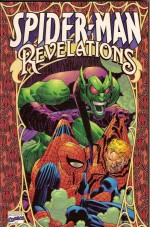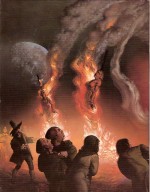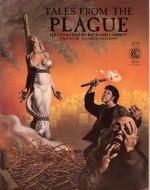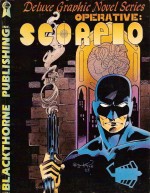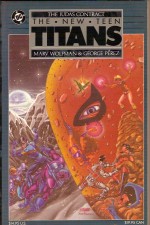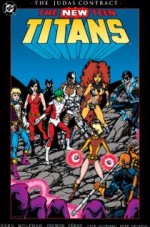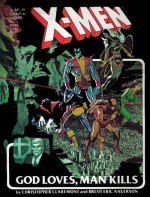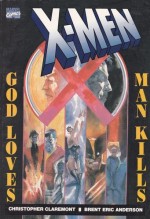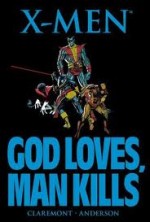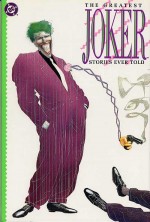
By various (DC Comics)
ISBN: 0-932289-36-6
When the very concept of high priced graphic novels was just being tested in the late 1980s DC Comics produced a line of glorious full-colour hardback compilations spotlighting star characters and celebrating standout stories from the company’s illustrious and varied history decade by decade.
They then branched out into themed collections which shaped the output of the industry to this day, such as this fabulous congregation of yarns which offered equal billing and star status to one of the most enduring arch-foes in fiction: the Monarch of Malignant Mirth known only as the Joker.
Devised as a bookend and supplementary edition to the Greatest Batman Stories Ever Told and devised in the run-up to the launch of the immensely anticipated 1989 Batman movie, this glorious comedy of terrors features an eclectic and absorbing selection of stories (co)starring the Clown Prince of Crime which followed him through the then five decades of his comicbook existence.
Edited by Mike Gold with associates Brian Augustyn and Mark Waid, this splendid tome opens with ‘The Joker’s Dozen’ by Gold, describing the history and selection process involved in choosing from the literally hundreds of eligible stories, and also includes an end-piece essay ‘Stacking the Deck: The other Joker Stories’ by Waid, expansive biographies on the creators involved, and a fabulous gallery of the striking covers from tales which didn’t make the final cut.
However, fascinating and informative as those features are, the real literary largesse is to be found in the 19 stirring tales which comprise the bulk of this tome…
One note of advisement: when this collection was released many of the stories’ creative details were lost, but have been rediscovered since. Many of the credits are mistaken or just plain wrong, so wherever possible I’ve substituted the current attributions.
The suspenseful entertainment opens with ‘Batman vs. The Joker from Batman #1 (Spring 1940 by Bill Finger, Bob Kane & Jerry Robinson) which introduced the greatest villain in the Dark Knight’s rogues’ gallery via a stunning tale of brazen extortion and wilful wanton murder.
A year later ‘The Case of the Joker’s Crime Circus’ (Batman #4, Winter 1941) saw the Mountebank of Menace plunged into depressive madness before recruiting a gang from the worst that the entertainment industry and carnival trade could offer; setting off on a renewed course of plunder, mayhem and death…
‘The Joker and the Sparrow’ comes from the Sunday section of the short-lived Batman syndicated newspaper strip (from October 28th – December 9th 1945, but misattributed to 1946 in this volume) wherein Alvin Schwartz, Hardin “Jack†Burnley & Charles Paris recount the gripping and often hilarious war between the Deadly Jester and a mysterious new contender for the title of “Gotham’s Cleverest Criminalâ€â€¦
‘The Man Behind the Red Hood’ (Detective Comics #168, February 1951) finally gave the Joker an origin in a brilliantly engrossing mystery by Finger, Lew Sayre Schwartz & Win Mortimer, which all began when the Caped Crusader regaled criminology students with the story of “the one who got awayâ€â€¦
‘The Joker’s Crime Costumes’ comes from Batman #63 (February/March 1951, by Finger, Dick Sprang & Charles Paris), recounting how the Laughing Larcenist impersonated famous historical comedy figures and clowns such as Falstaff, Mr. Pickwick and Old King “Coal†to commit modern day mayhem.
Batman #73, (October/November 1952, by pulp sci fi writer David Vern, Sprang & Paris) described a classic clash with the Dynamic Duo temporarily stymied by ‘The Joker’s Utility Belt’ as the Harlequin of Hate created his own uniquely perverse iteration of the heroes’ greatest weapon and accessory whilst, almost simultaneously over in World’s Finest Comics #61 (November 1952), ‘The Crimes of Batman’ by Vern, Kane & Paris found Robin a hostage and the Gotham Gangbuster compelled to commit a string of felonies to preserve the lad’s life. Or so the Joker vainly hoped…
From a period when the Joker appeared almost once a month in one Bat-title or other, Alvin Schwartz, Sprang & Paris concocted something extra-special for Batman #74 (December 1952-January 1953). ‘The Crazy Crime Clown’ had the exotic but strictly larcenous Baroque Bandit apparently go bonkers and end up committed to the Gotham Institute for the Insane. Of course, there was method in the seeming madness as Batman discovered when he infiltrated the worthy asylum in disguise…
By the time of World’s Finest Comics #88 (May/June 1957) the solo strips of the Man of Steel and Caped Crusader therein had amalgamated into a series of shared adventures, and ‘Superman and Batman’s Greatest Foes (by Edmond Hamilton, Sprang & Stan Kaye) offered a clever mystery as “reformed†villains Lex Luthor and the Joker set up in the commercial robot business as a blind for their most audacious scheme whilst in Batman #110 (September 1957), the ‘Crime-of-the-Month Club’ by Dave Wood, Sprang & Paris, a series of seemingly unconnected but brilliant robberies proved to be the Joker’s latest scheme: selling his felonious plans to other thieves while he worked on a much grander scheme…
‘The Great Clayface-Joker Feud’ (Batman #159 November 1963) was a bright moment at the otherwise uninspired tail-end of a bad period in Batman’s history. Bill Finger, Jim Mooney & Sheldon Moldoff produced a big story where two arch-rivals first competed and then became allies to almost overwhelm the Dynamic Duo and the original Batwoman and Bat-Girl too, whilst ‘The Joker Jury’ (Batman #163, May 1964 by Finger, Moldoff & Paris) found Robin and his mentor trapped in the criminal enclave of Jokerville, where every citizen was a criminal dressed up as the Clown Prince and where all lawmen were outlaws.
This was the very last old guard story: with the next issue Julie Schwartz ushered in his streamlined, more down-to-Earth “New Look†Batman and super-villains all but disappeared from the scene…
At least until the Batman TV show took the world by storm. Up next is a rarely seen and quite lovely tale by E. Nelson Bridwell, Carmine Infantino & Murphy Anderson which appeared in the Premium promotional giveaway Batman Kelloggs Special 1966.
‘The Joker’s Happy Victims’ is sheer graphic poetry in motion as the Dynamic Duo were forced to extraordinary measures when all the victims of the Riotous Rogue’s latest rash of robberies refused to press charges…
During the late 1960s superheroes experienced a rapid decline in popularity – possibly in reaction to the mass-media’s crass and crushing over-exposure – and the Batman books sought to escape their zany, “camp†image by methodically re-branding the character and returning to the original 1930s concept of a grim and driven Dark Avenger.
Such a hero demanded far deadlier villains and with one breakthrough tale Denny O’Neil, Neal Adams & Dick Giordano also reinstated the psychotic, diabolically unpredictable Killer Clown who scared the short pants off the readers of the Golden Age Dark Knight.
‘The Joker’s Five-Way Revenge’ (Batman #251, September 1973) is a genuine classic that totally redefined the Joker for our age as the Mirthful Maniac stalked his old gang, determined to eradicate them all as the hard-pressed Gotham Guardian desperately played catch-up. As the crooks died in all manner of Byzantine and bizarre ways, Batman realised his arch-foe has gone irrevocably off the deep end. Terrifying and beautiful, for many fans this is the definitive Batman/Joker story.
Brave and the Bold #111 (February/March 1974) boasted “the strangest team-up in history†as Batman joined forces with his greatest enemy for a brilliantly complex tale of cross and double cross in ‘Death has the Last Laugh!’ – by Bob Haney & Jim Aparo – which may well have lead to the Harlequin of Hate’s own short-run series a year later.
‘The Last Ha Ha’ came from The Joker # 3 (September 1975, written by O’Neil with art from Ernie Chan/Chua & José Luis GarcÃa-López) wherein a robbery and the kidnap of star cartoonist Sandy Saturn, by a green-haired, laughing loon, led the cops to the ludicrous conclusion that The Creeper was the culprit. Cue lots of eerie cackling, mistaken identity shenanigans and explosive action…
When Steve Englehart, Marshall Rogers and Terry Austin took over the Batman feature in Detective Comics their landmark retro-styled collaboration utterly revitalised the character for a new generation of readers.
Their undoubted peak in a short but stellar run naturally starred the Dark Knight’s nemesis as his most chaotic beginning with ‘The Laughing Fish’ in #475 (February 1978) and spectacularly culminating a month later in ‘The Sign of the Joker!’, comprising one of the most reprinted Bat-tales ever concocted, and even adapted as an episode of the award-winning Batman: The Animated Adventures TV show in the 1990s. In fact you’ve probably already read it. But if you haven’t… what a treat you have awaiting you!
As fish with the Joker’s horrific smile began turning up in sea-catches all over the Eastern Seaboard the Clown Prince attempted to trademark them. When patent officials foolishly told him it can’t be done, they start dying… publicly, impossibly and incredibly painfully…
The story then culminated in a spectacular apocalyptic clash which shaped and informed the Batman mythos for the next two decades…
This terrific tome then concludes with ‘Dreadful Birthday, Dear Joker…!’ from Batman #321 (March 1980), by Len Wein, Walt Simonson & Giordano, wherein the Malevolent Mummer planned to celebrate his anniversary in grand style: kidnapping a bunch of old friends like Robin, Jim Gordon, Alfred, Catwoman and others to be the exploding candles on his giant birthday cake…
The Joker has the rare distinction of being perhaps the most iconic villain in comics and can claim that title in whatever era you choose to concentrate on; Noir-ish Golden Age, sanitised Silver Age or malignant modern and Post-Modern milieus. This book captures just a fraction of all those superb stories and with the benefit of another two and a half decades of material since the release of this compendium, just think of what a couple of equally well-considered sequels might offer…
Slightly differing versions of this initial hardback volume have been released as the paperback editions Stacked Deck: The Greatest Joker Stories Ever Told in 1990 and The Joker: Greatest Stories Ever Told in 2008.
© 1939-1983, 1988 DC Comics Inc. All rights reserved.
